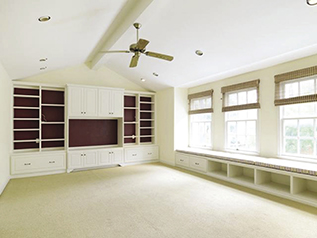A cannonball whizzes past your head, hurtling toward the floor of your ship, and your body braces for impact. But just before the panic sets in, you remember that you aren’t standing alongside Russell Crowe in the action/adventure film “Master and Commander,” but rather sitting on a couch inside a Devonshire home.
This powerful viewing experience is exactly what homeowner Nicholas Wood aimed to achieve last summer when he began transforming his upstairs family room into a home theater. He wanted to distinguish his space from the standard home theater and captivate his guests with high-tech, cinema-quality sound.
Wood estimates that the sound system emits about 18,000 watts of power.
“It’s about the same amount of power in a commercial movie theater, packed into a room about a tenth of the size,” he explains.
He says typical home theaters have around 500-1,000 watts. The formidable audio system, projector and lighting all are controlled via iPhone from the palm of his hand.
[quote align=”right” color=”#000000″]“It’s about the same amount of power in a commercial movie theater, packed into a room about a tenth of the size.”[/quote]With all the electronics installed, Wood addressed soundproofing to ensure optimal audio inside the room while preventing any on-screen explosions from resonating outside the room. He embraced the engineering challenge, and using acoustically transparent fabric, fire-retardant rock wool and two inches of soundproofing material in the walls, the home theater came to life. However, the work of designing a stylish interior to camouflage the electronics remained.
“You usually see a popcorn machine and a red curtain in a home theater, and I always thought that was kind of cheesy,” Wood says.
He designed all the fixtures and decor for the room using three-dimensional computer software before having everything custom-built. He went for a “library look” with a geometric Greek key design across the ceiling beam and on the Roman blackout shades adorning the windows.
“There’s definitely an old-cinema quality to the theater,” Wood says.








